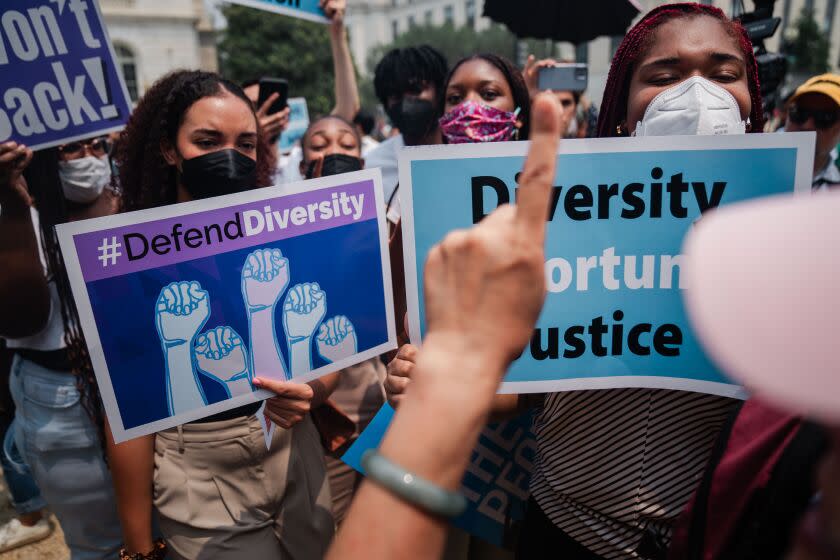Letters to the Editor: Supreme Court's affirmative action ruling warps history

To the editor: The overturning of affirmative action in college admissions by the U.S. Supreme Court does not simply show that the court is out of step with public opinion, which it clearly is. Nor does it simply reflect a partisan point of view.
This decision distorts American history. Our history and present society are not colorblind. Race is a factor in every aspect of life, but there have been real personal and cultural advancements stemming, in part, from affirmative action.
It is even more troubling when the affirmative action decision is seen alongside last year’s abortion decision. That decision also distorts history by harkening back to a vision of women as subservient without control of their own bodies and destinies. It ignores women’s professional and personal advancement, which at its core is based on personal autonomy over one’s body.
It is too simple a solution to ask the justices of the Supreme Court to reacquaint themselves with our history — for them to come out of their marble tower and learn about the changes in our history over the past 50 years. But we have to start somewhere. The justices should protect our heritage and history, not dismantle it.
Marcy Sheinwold, Laguna Woods
..
To the editor: Now that the Supreme Court has struck down affirmative action in college admissions, I wonder if will also prohibit admissions based on athletic prowess.
Or does the conservative majority place a higher value on the ability to sink baskets from outside the three-point line than it does in enrolling a diverse university student body?
Larry Harmell, Granada Hills
..
To the editor: In 1996, California voters decided to abolish the discriminatory effects of racial preferences in college admissions by passing Proposition 209.
Then, in 2020, after a dramatic change in the state's demographics over a 24-year period, proponents of affirmative action decided that the time was ripe to repeal Proposition 209 and put Proposition 16 on the ballot. It was decisively rejected by California voters, in favor of retaining the ban on racial preferences.
Apparently, in its editorial, The Times misses the point that the Supreme Court may have taken a cue from the people of California in deciding to outlaw affirmative action in college admissions.
Jim Redhead, San Diego
..
To the editor: Justices appointed by presidents who lost the popular vote have struck again. To listen to entitled fossils try to spin their hate under the guise of judicial fairness would be hilarious if it weren’t so bleak. We have sunk to the equivalent of "separate but equal" being offered as legal rationale again.
I truly believe the justices in the majority know they actually represent the minority. There is desperation mixed through all their specious garbage.
I never dreamed I would live in a time where a president could be elected while losing the popular vote twice in 16 years. I never dreamed I could live in a time where supposed legal giants would be so immoral with their pouting Wall Street Journal editorials and arrogant senses of entitlement.
How many more dominoes that protect our precious freedoms have to fall before the electoral college is abolished and Supreme Court impeachments and term limits are enacted?
Mark Diniakos, Thousand Oaks
..
To the editor: The Supreme Court’s decision to end affirmative action in admissions does not have to mean, as California has shown, the end of diversity at universities. Affirmative action was meant to be an adjustment to compensate for disparities in primary education. A focus on improving primary education is what is needed.
No eighth-grade history teacher should be faced with teaching students who struggle to read, nor should an algebra teacher have pupils who are unable to do long division. Moving students forward in school due to their age must stop.
If focused resources assured that all elementary school students were capable of reading, writing a paragraph, understanding arithmetic including multiplication, fractions and percentages prior to moving on to middle school, the need for affirmative action would diminish.
Replacing traditional grade levels with performance levels would narrow gas in learning while maintaining the value of a college degree, which is lessened if basic education that should be taught prior to college has to be offered at universities.
Glenn Egelko, Ventura
This story originally appeared in Los Angeles Times.

